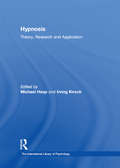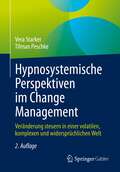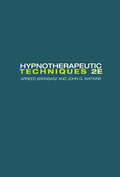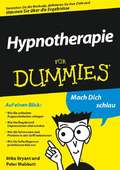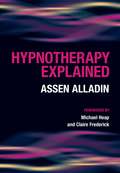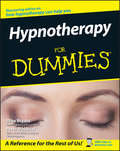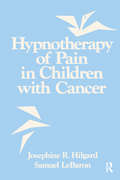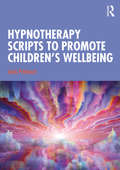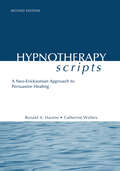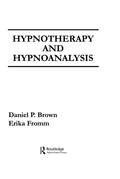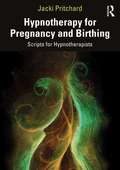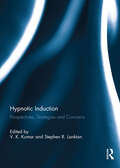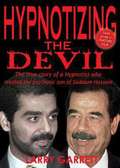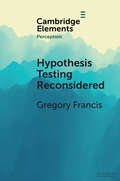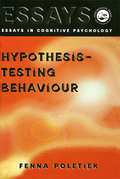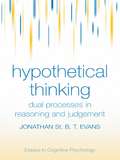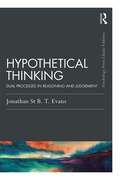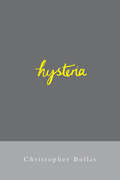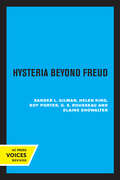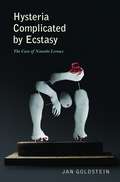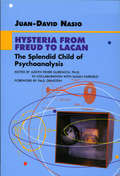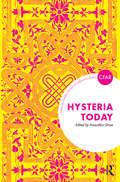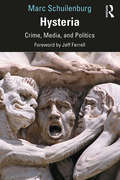- Table View
- List View
Hypnosis: Theory, Research and Application (The International Library of Psychology)
by Irving KirschModern hypnosis can be traced back to the 18th century and during this period mesmerism, as it was then known, was a healing practice which spread throughout Europe and North America. Since then hypnosis has been treated primarily as a psychological phenomenon and theories about hypnosis are grounded in mainstream psychology and its related disciplines. Most recently it has been subject to extensive clinical trials to investigate its therapeutic effectiveness. In their comprehensive introduction to this invaluable collection the editors trace the historical development of hypnosis, providing an excellent review of the theories that have tried to explain how hypnosis works and reflecting on the cultural and scientific attitudes and practices that prevailed at various times. They have selected the most important previously published papers that reveal how a scientific approach to understanding hypnosis as a psychological phenomenon has emerged over the last 70 years. They have also included a selection of reports on clinical applications and on legal and forensic issues. As such this volume will prove an invaluable reference resource for researchers and students already in the field and new scholars interested in learning more about hypnosis.
Hypnosystemische Perspektiven im Change Management: Veränderung steuern in einer volatilen, komplexen und widersprüchlichen Welt
by Vera Starker Tilman PeschkeDieses in zweiter Auflage komplett überarbeitete und erweiterte Buch stellt hypnosystemische und neurobiologische Ansätze zur Gestaltung von Veränderungsprozessen vor, mit dem Ziel, die Entwicklungsvarianz von Unternehmen in einer volatilen und komplexen Welt zu steuern und zu erhöhen. Unter Darstellung aktueller methodischer und empirischer Perspektiven zum Thema Change Management gehen die Autorin und der Autor vor allem der Frage nach, warum sich – trotz jahrzehntelanger Professionalisierung von Change-Management-Methoden – keine Steigerung der Erfolgsraten von Veränderungsprozessen verzeichnen lässt.Sie stellen neben konkreten Prozessgestaltungsansätzen unter anderem Vorschläge zu einer zieldienlichen Führung, zu einer wirksamen Team- und Kooperationsentwicklung sowie zur Messung von Veränderungsprozessen vor und eröffnen damit Management und Führungskräften neue Wege, die Erfolgswahrscheinlichkeit von künftigen Veränderungsprozessen, insbesondere im Hinblick auf die Anforderungen der digitalen Transformation und einer sich immer schneller wandelnden Welt, positiv zu beeinflussen. Der Inhalt Change Management aus hypnosystemischer SichtAktuelle Perspektiven und Erfolgswahrscheinlichkeiten im Change Management in einer volatilen und komplexen Welt Hypnosystemischer Beratungsansatz nach Gunther SchmidtAufbau eines Beratungs- und Steuerungssystems für Veränderungsprozesse
Hypnotherapeutic Techniques: Second Edition
by John G. Watkins Arreed BarabaszTwo premier hypnotherapists collaborate on a new edition of this award-winning text, a collection of techniques and information about hypnosis that no serious student or practitioner should be without. A thorough and practical handbook of various hypnotherapeutic measures, it contains illustrative examples and logically argued selection methods to help practitioners choose the ideal method for a needed purpose. Section by section, it breaks out the various methods and phenomena of hypnosis into easily digested chunks, so the reader can pick and choose at leisure. An excellent practical guide and reference that is sure to be used regularly. The authors have a wide and longstanding experience on the subject and thus can stay on clinically approvable methods.
Hypnotherapie für Dummies (Für Dummies)
by Mike Bryant Peter MabbuttUnter den vielen Therapienformen, die Menschen mit emotionalen Problemen oder stressbedingten Krankheiten helfen, zeigt die noch junge Hypnotherapie erstaunlich schnell große Erfolge. Die erfahrenen Hypnotherapeuten Mike Bryant und Peter Mabbutt erläutern die Wirkung von Entspannungsübungen und positiver Suggestion und zeigen, wie fließend die Grenzen zur Meditation und zum Neurolinguistischen Programmieren sind. Anhand vieler Beispiele erklären sie Ihnen, wie Sie durch Hypnotherapie belastende Gedanken und negatives Verhalten erkennen und ins Positive ändern können.
Hypnotherapy Explained
by Assen Alladin Glenn RobertHypnotherapy provides a powerful tool for utilizing the power of the mind to reduce distress and suffering. This concise guide provides readers with a rich source of ideas on starting hypnotherapy practice, and thinking seriously about hypnosis as a powerful adjunct to psychotherapy and medical interventions. With a clear definition of what hypnosis really is, readers can develop an understanding of the rationale for utilising hypnotherapy with particular disorders.As the medical community is progressively adopting a biopsychosocial model of healing, there is a serious move toward validating the scientific credibility of hypnosis, and hypnotherapy has become a well-established treatment. Unlike any other introductory text, "Hypnotherapy Explained" adopts a uniquely scientific approach among introductory texts; reviewing theories and offering practical ways to integrate hypnotherapy in medical, psychiatric and psychotherapeutic practice. It is enlightening reading for general practitioners, psychiatrists, psychologists and other healthcare professionals.
Hypnotherapy For Dummies
by Mike Bryant Peter MabbuttAn easy-to-follow, reassuring and responsible guide that shows how you can use hypnotherapy to identify and overcome unhealthy modes of thinking, deal with emotional issues, improve performance, and banish bad habits. Whether you're seeking to overcome anxiety or depression, improve your performance professionally or personally, lose weight or beat an addiction, hypnotherapy can help you make the changes you want.
Hypnotherapy Of Pain In Children With Cancer
by Josephine R. Hilgard Samuel LeBaronPresents findings on the effects of hypnosis in reducing anxiety and pain in children with cancer and suggests that hypnotherapy offers real promise of pain relief without drugs.First published in 1991. Routledge is an imprint of Taylor & Francis, an informa company.
Hypnotherapy Scripts to Promote Children's Wellbeing
by Jacki PritchardHypnotherapy Scripts to Promote Children’s Wellbeing is a collection of tried-and-tested scripts that will aid hypnotherapists in developing and implementing treatment plans for promoting the wellbeing of children. The book offers a variety of approaches solely focussed on children (aged 5 to 17 years), including: Ericksonian approaches utilising metaphors and story-telling; solution-focussed approaches; benefits approaches; parts therapy; Gestalt therapy and regression therapy. The scripts are intended to help deal with issues relevant to children such as lack of confidence; low self-esteem or self-worth; negative image; lack of motivation; anxiety (general, social and exam); learning and recalling information; fears; phobias; habits; sleep issues; bullying; abuse; bereavement and loss. Serving as a unique resource of techniques and compiled from the author's years of personal experience, this book is beneficial for students, newly qualified and experienced hypnotherapists alike.
Hypnotherapy Scripts: A Neo-Ericksonian Approach to Persuasive Healing
by Ronald A. Havens Catherine WaltersHypnotherapy Scripts, 2nd Edition is a straightforward, practical guide for doing Ericksonian hypnotherapy. This book not only explains the rationale for every step in the hypnotherapeutic process, it also contains sample scripts for each step. This edition of Hypnotherapy Scripts guides professionals through the construction of their own hypnotherapy induction and suggestion scripts. Verbatim sample transcripts of various induction and therapeutic suggestion procedures with detailed guidelines for creating one's own hypnotherapeutic inductions and metaphors are included. Recent research and writings on the role of unconscious processes, wellness, and positive psychology have been added to this edition. Also included is a detailed review of the diagnostic trance process, a therapeutic procedure unique to this text.
Hypnotherapy and Hypnoanalysis
by D. P. Brown E. FrommFirst published in 1986. Scientific hypnosis has made great advances particularly since World War II, both as part of basic psychological science concerned with the understanding of brain, mind, and personality and as a professional skill in which knowledge of hypnosis is used to serve human welfare by enhancing the quality of life for those who have the good fortune to benefit from hypnotherapy and the related practice of hypnoanalysis. The reader is brought abreast of these developments through the arrangement of the chapters into two sections of the book, with the first four chapters explaining the basics of hypnosis as an altered state of consciousness interpreted theoretically from several points of view.
Hypnotherapy for Pregnancy and Birthing: Scripts for Hypnotherapists
by Jacki PritchardThis practical volume provides resources and guidance for practising hypnotherapy with pregnant women and their birthing partners. Hypnotherapy for Pregnancy and Birthing begins with an overview of the topic and discusses a range of complex issues and vulnerabilities that might arise during sessions, before moving onto setting up and running group and/or individual sessions. Then, presenting techniques to work with pregnancy and birthing draws on a range of methodologies including solution-focused, metaphors (Ericksonian), Gestalt therapy, benefits approach and regression therapy. It covers: • Hypnosis, pregnancy and birthing • Getting into trance and relaxation • Breathing • Practising self-hypnosis and working on issues • Preparing for birthing • Bonding with baby • Working with worries, fears and phobias • Dealing with trauma and the unexpected • Loss and bereavement • Ego boosting. Containing over 70 customisable scripts and designed to stimulate reflection, this book is a valuable resource for student, newly qualified and experienced hypnotherapists working with pregnancy and birthing.
Hypnotherapy with Regrets and Associated Emotions: Ideas for Practice
by Jacki PritchardThis book helps hypnotherapists to focus on the subject of regrets and associated emotions when working with clients.Promoting the concept of “the road of regrets”, this book presents a five-stage process for the hypnotherapist to work through with clients (adults and children aged 5+). The process involves identifying and acknowledging regrets; working through the regrets and associated emotions; taking any necessary action before releasing the regrets and emotions; and finally moving on to plan for the future. The book contains over 60 customisable scripts, guidance notes and appendices to promote ideas for practice. The scripts offer a variety of methodology to choose from: regression (including past lives); metaphors (Ericksonian); benefits approach; Gestalt therapy and solution-focused. The appendices include practical resources such as questionnaires, checklists, summaries, forms, and worksheets for exercises which the hypnotherapist can utilise in sessions (individual or group).This practical volume will be of use to student hypnotherapists, trainers and training schools, supervisors, newly qualified and experienced hypnotherapists. Although the main focus of the book is regrets and associated emotions, the book can be used for an abundance of other concerns e.g. lack of confidence or self-esteem; fears; anxiety and panic attacks.
Hypnotic Induction: Perspectives, strategies and concerns
by V. K. Kumar and Stephen R. LanktonThe age-old notion of ‘hypnotic induction’ receives a fresh look from notable scholars from Canada, England, Sweden, and the USA in this book. These scholars represent a breadth of theoretical perspectives: cognitive-behavioral, Ericksonian, psychoanalytic, and trance-state. It is well known that a wide range of hypnotic induction protocols is used to prepare individuals to enhance their receptivity to test or clinical suggestions. However, despite its popularity of use, it appears that little is known about its relevancy and boundary conditions either for testing for hypnotisability or for enhancing clinical efficacy. In this volume, the authors reflect on issues surrounding its definitions, relevancy, possible components, and approaches; they also suggest considerations and strategies for optimizing inductions. This book will be of benefit to both newcomers to the field and seasoned researchers and clinicians alike – it can stimulate new thinking and research about this important, but often taken for granted, notion of hypnotic induction. This book was originally published as a special issue of the American Journal of Clinical Hypnosis.
Hypnotism And Mysticism Of India
by Ormond McgillThis book is the first of its kind that presents the secrets of Oriental Hypnotism (Maya) and the Real Magic of India. Its author, Ormond McGill, is a hypnotist of international reputation, Learn the real mental magic of India. Following an introduction in which Ormond McGill tells of the importance and exclusive nature of the material in this book, he explains how some of the world renowned feats of Hindu Fakir Magic are performed. Next, he gives you in depth instructions for performing the real Magic of the Mind, exactly as the advanced Hindu magicians are taught. You are shown how to control prana through Pranayama, Oriental Breathing Techniques, The Power of Yoga Concentration, Visualization and Projection of Thought, The Magic Force of Words and Sounds, Silent Psychic Influencing, and Yogi Mental Broadcasting. You proceed on into a knowledge of the High Magic of India, and are taught the reading of the Akashic Records, Astral Projection, and Yoga Cosmology. And you learn how to perform Yama, the Yoga Method of Self-Development. Of tremendous interest to hypnotists throughout the world, Ormond McGill teaches you the Yogi Art of Maya, and gives you his exclusive Occidental/Oriental Techniques of Hypnotizing.
Hypnotizing the Devil: The True Story of a Hypnotist Who Treated the Psychotic Son of Saddam Hussein
by Larry GarrettEveryone remembers where they were during the September 11 attacks in New York. Larry Garrett, a Chicago hypnotist will never forget, since he was in Saddam Husseins palace in Baghdad with Uday Hussein, Saddams eldest son. After an assassination attempt on Udays life, Larry Garrett was brought in to help with the recovery from the mental and physical pain. Larry writes about his account of dealing with the man often referred to as a psychopath, the CIA, a palace full of guards with machine guns, and visiting Babylon. The conversations about American culture and Uday Hussein's very surprising views, to getting the behind the scenes account at the palace as a World War begins. Larrys account of being the only American allowed into Iraq and hypnotizing the son of the most feared family in the World, will keep you in suspense. Larry Garrett has been in practice since 1968, operating the largest hypnosis centre in Chicago. He has received nationwide recognition for his outstanding contributions in hypnosis, including the 1991 Metzinger Award (which has only been presented six times) for contributions to the field of hypnosis.
Hypothesis Testing Reconsidered (Elements in Perception)
by Gregory FrancisHypothesis testing is a common statistical analysis for empirical data generated by studies of perception, but its properties and limitations are widely misunderstood. This Element describes several properties of hypothesis testing, with special emphasis on analyses common to studies of perception. The author also describes the challenges and difficulties with using hypothesis testing to interpret empirical data. Many common applications of hypothesis testing inflate the intended Type I error rate. Other aspects of hypothesis tests have important implications for experimental design. Solutions are available for some of these difficulties, but many issues are difficult to deal with.
Hypothesis-testing Behaviour (Essays in Cognitive Psychology)
by Fenna H. PoletiekHow do people search evidence for a hypothesis? A well documented answer in cognitive psychology is that they search for confirming evidence. However, the rational strategy is to try to falsify the hypothesis. This book critically evaluates this contradiction. Experimental research is discussed against the background of philosophical and formal theories of hypothesis testing with striking results: Falsificationism and verificationism - the two main rival philosophies of testing - come down to one and the same principle for concrete testing behaviour, eluding the contrast between rational falsification and confirmation bias. In this book, the author proposes a new perspective for describing hypothesis testing behaviour - the probability-value model - which unifies the contrasting views. According to this model, hypothesis testers pragmatically consider what evidence and how much evidence will convince them to reject or accept the hypothesis. They might either require highly probative evidence for its acceptance, at the risk of its rejection, or protect it against rejection and go for minor confirming observations. Interestingly, the model refines the classical opposition between rationality and pragmaticity because pragmatic considerations are a legitimate aspect of 'rational' hypothesis testing. Possible future research and applications of the ideas advanced are discussed, such as the modelling of expert hypothesis testing.
Hypothetical Thinking: Dual Processes in Reasoning and Judgement (Essays in Cognitive Psychology)
by Jonathan St. EvansHypothetical thought involves the imagination of possibilities and the exploration of their consequences by a process of mental simulation. In this Classic Edition, Jonathan St B T Evans’ presents his pioneering Hypothetical Thinking Theory; an integrated theoretical account of a wide range of psychological studies on hypothesis testing, reasoning, judgement and decision making. Hypothetical Thinking Theory is built on three key principles and implemented in a version of Evans' well-known heuristic–analytic theory of reasoning. The central claim of this book is that this theory can provide an integrated account of apparently diverse phenomena including confirmation bias in hypothesis testing, acceptance of fallacies in deductive reasoning, belief biases in reasoning and judgement, biases of statistical judgement and numerous characteristic findings in the study of decision making. Featuring a reflective and insightful new introduction to the book, this classic edition discusses contemporary theory on cognitive biases, human rationality and dual-process theories of higher cognition. It will be of great interest to researchers, post graduates as well as advanced undergraduate students.
Hypothetical Thinking: Dual Processes in Reasoning and Judgement (Psychology Press & Routledge Classic Editions)
by Jonathan St EvansHypothetical thought involves the imagination of possibilities and the exploration of their consequences by a process of mental simulation. In this Classic Edition, Jonathan St B. T. Evans presents his pioneering hypothetical thinking theory; an integrated theoretical account of a wide range of psychological studies on hypothesis testing, reasoning, judgement and decision making. Hypothetical thinking theory is built on three key principles and implemented in a version of Evans' well-known heuristic–analytic theory of reasoning. The central claim of this book is that this theory can provide an integrated account of apparently diverse phenomena including confirmation bias in hypothesis testing, acceptance of fallacies in deductive reasoning, belief biases in reasoning and judgement, biases of statistical judgement and numerous characteristic findings in the study of decision making. Featuring a reflective and insightful new introduction to the book, this Classic Edition discusses contemporary theory on cognitive biases, human rationality and dual-process theories of higher cognition. It will be of great interest to researchers, post graduates as well as advanced undergraduate students.
Hysteria
by Christopher BollasHysteria has disappeared from contemporary culture only insofar as it has been subjected to a repression through the popular diagnosis of 'borderline personality disorder'.In Hysteria the distinguished psychoanalyst Christopher Bollas offers an original and illuminating theory of hysteria that weaves its well-known features - repressed sexual ideas; indifference to conversion; over-identification with the other - into the hysteric form.Through a rereading of Freud, Bollas argues that sexuality in itself is traumatic to all children, as it 'destroys' the relation to the mother, transfiguring her from 'mamma', the infant's caregiver, to 'mother', the child's and father's sex object. For the hysteric this recognition is endlessly traumatic and the hysterical personality forms itself into an organised opposition to this knowledge.True to his earlier writings, Bollas' vision is thought provoking and mind expanding. Hysteria brings new perspectives to long-standing ideas, making enlightening reading for students and professionals involved in psychoanalysis and psychotherapy alike, as well as the lay reader who takes an interest in the formation of personality in western culture.
Hysteria Beyond Freud
by Roy Porter Elaine Showalter Sander L. Gilman Helen King G. S. Rousseau"She's hysterical." For centuries, the term "hysteria" has been used by physicians and laymen to diagnose and dismiss the extreme emotionality and mysterious physical disorders presumed to bedevil others—especially women. How did this medical concept assume its power? What cultural purposes does it serve? Why do different centuries and different circumstances produce different kinds of hysteria? These are among the questions pursued in this absorbing, erudite reevaluation of the history of hysteria. The widely respected authors draw upon the insights of social and cultural history, rather than Freudian psychoanalysis, to examine the ways in which hysteria has been conceived by doctors and patients, writers and artists, in Europe and North America, from antiquity to the early years of the twentieth century. In so doing, they show that a history of hysteria is a history of how we understand the mind. This title is part of UC Press's Voices Revived program, which commemorates University of California Press’s mission to seek out and cultivate the brightest minds and give them voice, reach, and impact. Drawing on a backlist dating to 1893, Voices Revived makes high-quality, peer-reviewed scholarship accessible once again using print-on-demand technology. This title was originally published in 1993.
Hysteria Complicated by Ecstasy: The Case of Nanette Leroux
by Jan GoldsteinA unique account of a peasant girl's mental illness in nineteenth-century FranceHysteria Complicated by Ecstasy offers a rare window into the inner life of a person ordinarily inaccessible to historians: a semiliterate peasant girl who lived almost two centuries ago, in the aftermath of the French Revolution. Eighteen-year-old Nanette Leroux fell ill in 1822 with a variety of incapacitating nervous symptoms. Living near the spa at Aix-les-Bains, she became the charity patient of its medical director, Antoine Despine, who treated her with hydrotherapy and animal magnetism, as hypnosis was then called. Jan Goldstein translates, and provides a substantial introduction to, the previously unpublished manuscript recounting Nanette's strange illness—a manuscript coauthored by Despine and Alexandre Bertrand, the Paris physician who memorably diagnosed Nanette as suffering from "hysteria complicated by ecstasy." While hysteria would become a fashionable disease among urban women by the end of the nineteenth century, the case of Nanette Leroux differs sharply from this pattern in its early date and rural setting.Filled with intimate details about Nanette's behavior and extensive quotations of her utterances, the case is noteworthy for the sexual references that contemporaries did not recognize as such; for its focus on the difference between biological and social time; and for Nanette's fascination with the commodities available in the region's nascent marketplace. Goldstein's introduction brilliantly situates the text in its multiple contexts, examines it from the standpoint of early nineteenth-century medicine, and uses the insights of Foucault and Freud to craft a twenty-first-century interpretation.A compelling, multilayered account of one young woman's mental afflictions, Hysteria Complicated by Ecstasy is an extraordinary addition to the cultural and social history of psychiatry and medicine.
Hysteria From Freud to Lacan (Lacanian Clinical Field Ser.)
by Juan-David NasioIn the English-speaking psychoanalytic world, few diagnostic categories are as controversial as hysteria. This concept, widely held to reflect outmoded cultural prejudices aganist women, has virtually disappeared from our theoretical literature, diagnostic manuals, and traning programs. However far from being gender-bound, hysteria from Jacques Lacan represents a psychic strategy that bears on one of the most fundamental preoccupations of existence: What does it mean to be a woman? What does it mean to be a man?
Hysteria Today (The Centre for Freudian Analysis and Research Library (CFAR))
by Anouchka GroseHysteria, one of the most diagnosed conditions in human history, is also one of the most problematic. Can it even be said to exist at all? Since the earliest medical texts people have had something to say about 'feminine complaints'. Over the centuries, theorisations of the root causes have lurched from the physiological to the psychological to the socio-political. Thanks to its dual association with femininity and with fakery, the notion of hysteria inevitably provokes questions about women, men, sex, bodies, minds, culture, happiness and unhappiness. To some, it may seem extraordinary that such a contested diagnosis could continue to merit any mention whatsoever. Hysteria Today is a collection of essays whose purpose is to reopen the case for hysteria and to see what relevance, if any, the term may have within contemporary clinical practice.
Hysteria: Crime, Media, and Politics
by Marc SchuilenburgAccording to the medical world, hysteria is a thing of the past, an outdated diagnosis that has disappeared for good. This book argues that hysteria is in fact alive and well. Hyperventilating, we rush from one incident into the next – there is hardly time for a breather. From the worldwide run on toilet paper to cope with coronavirus fears to the overheated discussions about immigration and overwrought reactions to the levels of crime and disorder around us, we live in a culture of hysteria. While hysteria is typically discussed in emotional terms – as an obstacle to be overcome – it nevertheless has very real consequences in everyday life. Irritating though this may be, hysteria needs to be taken seriously, for what it tells us about our society and way of life. That is why Marc Schuilenburg examines what hysteria is and why it is fuelled by a culture that not only abuses, but also encourages and rewards it. Written in a clear and direct style, this book will appeal to students and scholars of sociology, criminology, philosophy and all those interested in hysteria and how it permeates late modern society.
